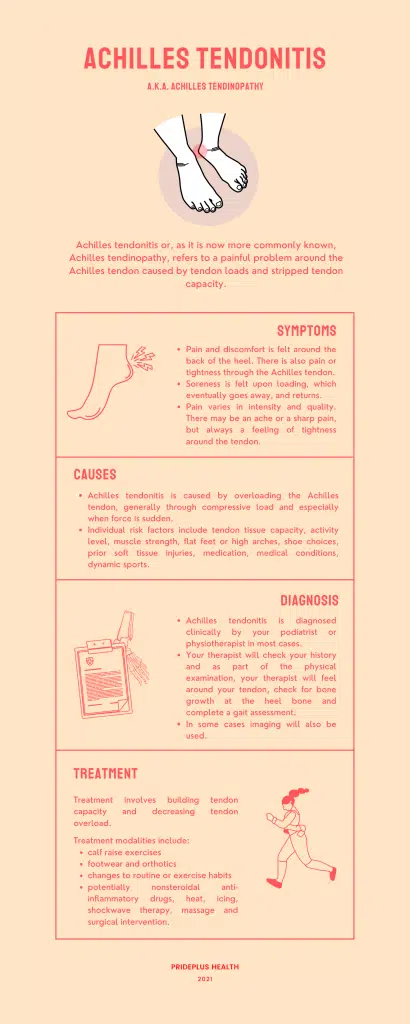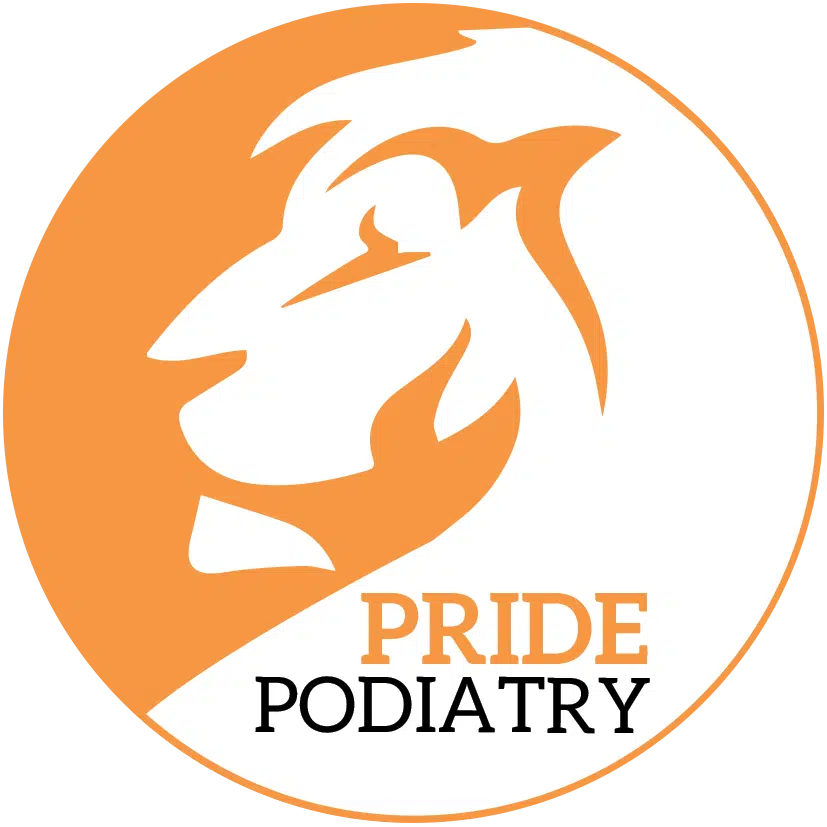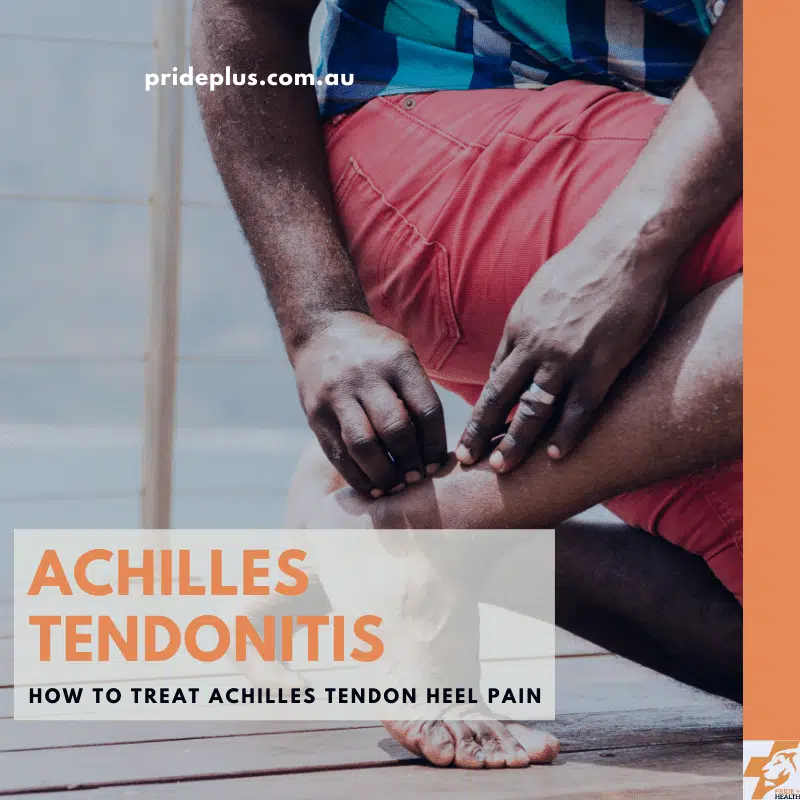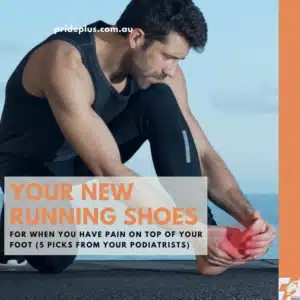Achilles tendonitis. When you can’t run, jump, or even walk without wincing.
It makes you feel like you’re dragging around a 10 ton truck tyre. Every morning you feel the heavy stiffness. Ranges from a dull ache to ‘shoot-me-now’ levels. Even resting isn’t a surefire escape.
So what’s happened to you pop, spring and speed?
Is there hope? Can you get back to feeling great again? A spring in your step, speed in your stride, and a smile on your face.
The good news, you can. But tendons are tricky, and you’re going to need to strap in, make some changes and be prepared to build yourself some new stretchy tendon again.
If you want to heal fast?
Bookmark this page (there’s more info on your achilles tendonitis you’re going to want to digest later) and come and see me and my podiatry colleagues now to get your achilles tendonitis treatment plan. We’ll work out your exact unique causes of your tendonitis and address your specific needs.
And for when you’re coming back reviewing all things achilles tendonitis here’s what you can find here.
- What actually is achilles tendonitis and what are the symptoms
- The many varied causes of achilles tendonitis
- Diagnosis and treatment
- Mythbusing and FAQ
- Infographic
What is Achilles Tendonitis
Achilles tendonitis is the old fashioned term for a painful problem around the achilles tendon. In these modern times it’s more commonly known as achilles tendinopathy. Even more specifically it will be differentiated to either mid-portion achilles tendinopathy or insertional achilles tendinopathy.
In this post we will use tendonitis and tendinopathy interchangeably to keep everyone happy and comfortable. For those of us a little older who learned it as tendonitis back in school and also for those young ones who learned about tendinopathy.
We’ll briefly touch on a noninsertional achilles tendon injury versus an injury at the tendon insertion. For more detail on this we’ll create another post in the future. For the basics on what the achilles tendon is and does, think of it as the major puppet string that connects our calf muscles to our foot.
When the puppeteer (our calf muscles) pull on our achilles tendon fibers the puppet (our foot) points down to the ground. When walking, running and jumping this is the big motor that powers our upwards and forwards momentum. As a band of tissue, the achilles tendon is the biggest and strongest in the human body.
Symptoms of Achilles Tendonitis
Pain and discomfort around the back of the heel pain through the achilles tendon is the most common symptom of achilles tendonitis. What makes achilles tendonitis a bit different from other painful conditions that effect the heel is the pattern of painful symptoms.
Typically, achilles tendonitis is quite touchy and sore when you first start loading your tendon. This might be when you first get up out of bed in the morning or after you get moving after sitting down for a while. For some of us, the pain or ache is present when we first start our physical activities. It might be achey, sore and stiff for say the first 5 minute of your 40 minute jog or run.
Then, during your activities something strange happens, particularly if your achilles tendonitis pain is only recent. It goes away! For many there will be a few sore steps or a few painful minutes to start running but as you get moving and warmed up there will be time when you’re absolutely pain free.
For those who have more severe or longer duration of achilles tendonitis symptoms the pain can return again with increased time on your feet.
Speaking from personal experience here as someone who fought through achilles tendinopathy over a 6 month period I was able to run for around 30 minutes pain free but as I increased my time the pain started to come back and with increasing intensity when I reached over the 40 minute mark.
So, a variability in pain through the back of the heel is a key symptom of achilles tendonitis. The pain varies with intensity (how much pain) and also with quality. Some sufferers report only an ache, others sharp pain. Most report a dull ache at times, sharp at others and always a feeling of tightness through the tendon.
The Causes of Achilles Tendonitis
Achilles tendonitis is caused by overloading the achilles tendon. This is not as straight forward as just running too far or walking too much. To understand why an achilles tendon becomes irritated and sore we need to understand two different types of load.
Compressive load and tensile load.
Tensile load is the type of loading our tendons handle fantastically well. They grow and develop to have a matrix structure which is optimised to undergo tensile loading where the tendon is pulled from each end. Think of pulling on the ends of a rubber band. As the band gets stretched it is undergoing mainly tensile loading.
Compressive load is what our bones are exceptional at handling, but not so our tendons. With compression loading a tissue or structure is squished more than it is pulled. Due to the structure of a tendon it’s far less optimised to handle this compressive load (hey, that’s what your bones are for).
So, this means that your achilles tendon can take a mammoth amount of tensile loading (pulling) before it starts to develop into achilles tendinopathy. It does not take any where near as much compressive loading before tendonitis sets in.
In reality, this means that if we have a heel bone that tilts in or out (movements known as inversion and eversion or pronation and supination) under load we get significant amounts of compression within the tendon itself. Some people might not know if these movements are related to their feet. Another way of thinking of them is having flat feet or high arched feet. These “structural” appearances usually indicate your heel is tilting one way or the other.
Other Causes Include
Another factor that contributes to achilles tendinitis is not just the type of force but the rate of force application. By now if you’re thinking this sounds like high school physics, you’re correct (and sorry). This podiatrist is a full on geek for the physics and properties of tendons.
Applying a force slowly to a tendon is much easier for our tendons to handle than a sudden increase in load. You’ll find that walking is much easier on tendons than running which is easier than sprinting or jumping.
In practice this means that there could be many “causes” of your achilles tendonitis. Yes you’re asking your achilles tendon to do more work but what kind of over work? Is it too much compression, is it too fast, or is it both?
And this is even before we work out what the actual starting capacity of your achilles tendon to do work is! As we age our tendon loses capacity. If our muscles lose strength their tendon attachments lose capacity. Medical conditions such as diabetes reduces tendon capacity. Drugs including steroids and some classes of antibiotics reduce tendon capacity.
To summarise, your achilles tendonitis is caused by working your tendon too hard. Why that’s happening? There’s many long and detailed answers but only one is specific to you and your tendon. Your individual risk factors might include:
- Tendon tissue capacity
- Activity level
- Muscle strength
- Flat feet or high arches
- Shoe choices
- Previous soft tissue injuries
- Medications
- Medical conditions
- Dynamic sports involving jumping and sprinting
How Achilles Tendonitis is Diagnosed
Achilles tendonitis is diagnosed clinically by your podiatrist or physiotherapist in most cases. A thorough physical examination combined with physical tests and history will give your therapist an indication and diagnosis.
Your therapist will touch around and feel what your tendon tissue feels like. We look for extra bone growth at the heel bone (known as a Haglund’s deformity) and complete a gait assessment as part of your physical examination.
In some cases imaging will also be used. X-ray imaging is not particularly useful when looking at tendons however ultrasound imaging and magnetic resonance imaging can both be useful. With an ultrasound you’ll be able to clearly see the tendon shape, quality and what the actual tendinopathy process is. There’s often areas of thickened tendon that builds up the longer you suffer with tendonitis.
Both MRI and ultrasound imaging can be useful to differentiate between achilles tendonitis and inflammation or fluid around the tendon itself. This is a separate condition known as paratenonitis which can effect the achilles tendon.
Achilles Tendonitis Treatment
Treatment options for achilles tendonitis include:
- Calf raise exercises
- Shoe Inserts (Orthotics, Arch supports & Heel Raises)
- The best shoes for Achilles tendonitis
- Changes to Exercise Routine or Exercise Habits
- And potentially nonsteroidal anti-inflammatory drugs, heat, icing, shockwave therapy, massage and surgical intervention.
Achilles tendonitis is treated effectively with appropriate measures to build tendon capacity and decrease tendon overload. In practice this will involve specific tendon and muscle strengthening exercises to increase the capacity of your tendon to do work.
For achilles tendonitis the focus will be on the soleus and gastrocnemius muscles which make up the calf muscle. Soleus is the primary “tightener” of the achilles tendon which is required to be strong for us to move about effectively. An example of an exercise which when dosed correctly will build soleus strength is the seated calf raise.
The gastrocnemius muscles also attaches into the achilles tendon and sits more superficial to the soleus. Whilst the gastroc (for short) muscle doesn’t take quite as much load as soleus strength gains here are still vital to treat achilles tendinopathy. A standing calf raise when completed with good technique and dosed correctly will build gastrocnemius strength.
To treat the tendon overload your podiatrist or physiotherapist may prescribe a variety of measures. Shoes with a higher heel pitch or drop reduce tendon loads more than flat shoes. Orthotics, orthoses or innersoles can be prescribed to reduce tendon compression if there is significant tilting of the heel bone during gait. Extra wedges inside shoes can also be used to decrease peak tendon loads.
Whilst not something that will effectively treat the cause of achilles tendonitis, medications such as anti-inflammatory drugs can be effective in treating associated pain. As with every treatment, there are adverse risks here. Anti-inflammatory medicines can be useful for temporary pain relief however they can disrupt the healing process in the long term.
What Doesn’t Work So Well
Steroid injections were previously used to treat achilles tendonitis however the risk of tendon rupture has seen this go out of favour.
Another treatment which has only started going out of favour, despite years of research is static stretching. The calf stretch used to be prescribed for achilles tendonitis as the tightness we all feel when we suffer from tendonitis intuitively steers us towards stretching as a treatment. Don’t fall for this.
Our tendons feel tight when their overworked in combination with their muscle. If your calf and achilles feel tight then stretching will not help in the long term. It will also lead to reduction in short term performance and only a very temporary increase in muscle/tendon length.
To get a longer, stronger calf and achilles tendon there is only one way. You must complete appropriate calf raise exercises focussing on both soleus and gastrocnemius with a dose heavy enough to induce sarcomerogenisis. This is where you build more long and strong muscle units (sarcomeres) which can then work and prevent you from feeling tight in your calf again.
Adjunctive treatments such as ice, heat, massage, dry needling can all count as 1%ers. They might lead to a small change in your achilles tendonitis symptoms however they are not addressing the root cause. If you’re treatment plan involves the appropriate capacity building exercises and load optimisation then adding in these 1%ers can be a nice bonus. But doing only the 1%ers is not going to lead to good outcomes for most achilles tendons.
Extracorporeal shockwave therapy is a more modern treatment which has shown to be very promising as an adjunctive treatment.
Frequently Asked Questions
What causes Achilles Tendinosis?
Achilles tendinosis is another name for achilles tendinopathy or achilles tendinitis. Tendon load and demands outstripping tendon capacity causes achilles tendinosis.
How do I know if my Achilles is inflamed?
Your podiatrist or physical therapist will be able to tell you if your achilles tendon is inflammed. You might be able to feel some heat and swelling yourself around your achilles tendon in between the gap from the lower part of your calf muscle and the top of your heel bone.
Can I exercise through an achilles tendon injury?
You absolutely must exercise appropriately through an achilles tendon injury. Your exact dosage of exercise will be very specific to you and your needs which must be prescribed by your podiatrist or physio.
As we touched on earlier, calf raise exercises both seated and standing are usually vital to treat an achilles tendon injury and resolve tight calf muscles.
Physical activity is also important to maintain whilst you rehabilitate your achilles tendon. In the early phases of tendon rehab lower loading exercises such as walking, cycling or swimming can be beneficial. As your tendon healing progresses your physical activity can get faster and more intense. Walking can become running and jumping. Flat surfaces can become uneven surfaces. Low impact activities can become high impact exercise.
Will surgery fix achilles tendonitis?
You very rarely need surgery to fix your achilles tendonitis. Luckily for us all our tendons are very good at adapting and changing through exercise. If the largest tendon in your body is sore then working proactively with your physical therapy will likely get you to a happy outcome.
Why do other people recover from achilles tendinopathy faster than me?
If we all optimise our own achilles tendon healing we’ll all recover at slightly different rates. Some of us will get better and achieve our goals faster than others.
This can be due to individual differences in our ability to build new healthy tendon. It can also vary due to our ability to recover. If we’re highly stressed, not sleeping or have comorbidities (or just getting on in years) our tendon healing rate will be slower than our young and rested counterparts.
During this time there can be some dark days. Times where you’ve been doing your rehabilitation exercises but feeling like you’re not making progress. For most of us, this is normal. We can’t click our fingers and make our tendons brand new, stretchy and strong (believe me, I tried!). Tendon damage is permanent but tendonitis is not. Keep working with your physio or podiatrist and you’ll eventually cross the divide where your tendon capacity again outstrips your daily tendon demands.
Achilles Tendonitis Infographic

Before you go
If you’ve read this far and not yet made the call to join the hundreds of your fellow sufferers of achilles pain by booking in with your Pride Podiatrist, now’s a great time to choose a time that suits you.
About the Author

Melbourne podiatrist, runner, clinical educator and oh – previous sufferer of achilles tendonitis Tim Mulholland wants to help you get back to your best. When not sharing his learnings from well over a decade of clinical podiatry and teaching other podiatrists you’ll find him out running the tracks of Melbourne with a smile on his face and his spring back in his heels.




